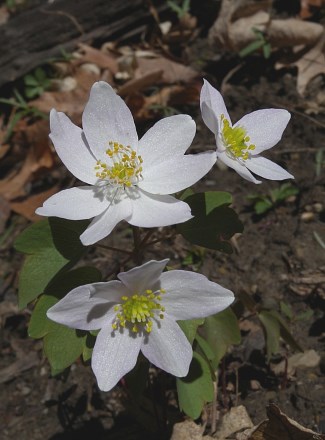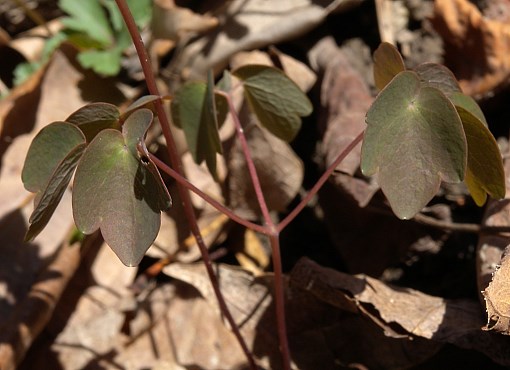Description:
This
perennial wildflower is 4-8" tall. A non-flowering plant
produces a whorl of trifoliate basal leaves on slender stems; each
basal leaf typically has 3 leaflets on a long slender petiole. The
basal stems are light green to reddish purple, unbranched, terete, and
hairless; the stems of flowering plants are similar. Individual
leaflets are up to 1½" long and 1" across; they are obovate or broadly
oblong in shape. The outer margin of each leaflet has 3 blunt lobes,
otherwise the margins are usually smooth. Sometimes there are 1-2 blunt
teeth along the outer margin of a leaflet. The upper surface of each
leaflet is medium green to purplish
green and hairless, while the lower
surface is pale green and hairless. A reticulate network of veins is
conspicuous on the lower surface. At the base of each leaflet, there is
a slender stalk (petiolule)
about ¼" long. Toward the middle of its stem, a flowering plant
sometimes produces a whorl of cauline leaves that resembles the whorled
basal leaves. At its apex, this stem terminates in a whorl of
trifoliate leaves or simple leaflets (sometimes including a combination
of the two). These terminal leaves and leaflets resemble the leaves and
leaflets of the basal and cauline leaves. Immediately above the
terminal leaves or leaflets is a loose umbel of 1-5 flowers. The
slender pedicels of the flowers are up to 1½" long. The diurnal flowers
are ½–1" across; the central flower is usually a little larger in size
than any lateral flowers. Each flower has 5-10 petal-like sepals, a
dense cluster of small green pistils in the center, and a ring of
conspicuous stamens. The petal-like sepals are white or pinkish white,
while the stamens have white filaments and yellow anthers. There are no
true petals. The blooming period occurs from mid- to late spring for
about 3 weeks. Each flower is replaced by a cluster of 4-15 achenes.
Each achene is about 1/3" (8 mm.) in length, terminating in a slightly
hooked
beak. Inside each achene, there is a single seed. The root system
consists of fibrous roots; the upper roots near the base of a plant are
somewhat fleshy and swollen. This wildflower spreads by reseeding
itself.
is medium green to purplish
green and hairless, while the lower
surface is pale green and hairless. A reticulate network of veins is
conspicuous on the lower surface. At the base of each leaflet, there is
a slender stalk (petiolule)
about ¼" long. Toward the middle of its stem, a flowering plant
sometimes produces a whorl of cauline leaves that resembles the whorled
basal leaves. At its apex, this stem terminates in a whorl of
trifoliate leaves or simple leaflets (sometimes including a combination
of the two). These terminal leaves and leaflets resemble the leaves and
leaflets of the basal and cauline leaves. Immediately above the
terminal leaves or leaflets is a loose umbel of 1-5 flowers. The
slender pedicels of the flowers are up to 1½" long. The diurnal flowers
are ½–1" across; the central flower is usually a little larger in size
than any lateral flowers. Each flower has 5-10 petal-like sepals, a
dense cluster of small green pistils in the center, and a ring of
conspicuous stamens. The petal-like sepals are white or pinkish white,
while the stamens have white filaments and yellow anthers. There are no
true petals. The blooming period occurs from mid- to late spring for
about 3 weeks. Each flower is replaced by a cluster of 4-15 achenes.
Each achene is about 1/3" (8 mm.) in length, terminating in a slightly
hooked
beak. Inside each achene, there is a single seed. The root system
consists of fibrous roots; the upper roots near the base of a plant are
somewhat fleshy and swollen. This wildflower spreads by reseeding
itself.
Cultivation:
Rue Anemone is best planted under deciduous trees. It prefers dappled
sunlight during the spring, but tolerates considerable shade later in
the year. Moisture levels should be mesic to slightly dry, and the soil
should contain loose loam and rotting organic material. Most growth and
develop occurs during the spring; it is not aggressive.
Range & Habitat:
Rue Anemone is occasional throughout Illinois (see Distribution
Map), where it is native. Habitats include mesic to dry
deciduous woodlands,
wooded slopes, and thinly wooded bluffs. This wildflower is
usually found in above-average to high quality woodlands where the
original ground flora is largely intact.
Faunal Associations:
The flowers offer only pollen as a reward to insect visitors. Typical
floral visitors include various bees, Syrphid flies, and bee flies
(Bombyliidae); the
bees usually collect pollen, while the flies feed on pollen. Some of
these insects explore the showy flowers for nectar in vain. Honeybees,
little carpenter bees (Ceratina
spp.), cuckoo bees (Nomada
spp.), mason
bees (Osmia spp.),
Halictid bees, and Andrenid bees have been observed
as visitors to the flowers. Because the foliage is toxic and relatively
inconspicuous, it is usually ignored by mammalian herbivores.

Photographic
Location:
Near the top of a wooded slope in Vermilion County, Illinois.
Comments:
Rue Anemone (Anemonella
thalictroides) is one of many showy wildflowers that
develop in deciduous
woodlands during the spring. Both the flowers and foliage are quite
attractive. Because the flowers move around easily in the wind, it is
sometimes called 'Windflower.' Another scientific name of this species
is Thalictrum thalictroides. Rue Anemone resembles Enemion
biternatum (False Rue Anemone), but its flowers have more
petaloid sepals (typically 6-9), while the flowers of False Rue Anemone
have only 5 petaloid sepals. Furthermore, its leaves and flowers are
arranged in whorls to a greater extent than those of False Rue Anemone.
While Rue Anemone is sometimes assigned to the Thalictrum genus, other Thalictrum
spp. in Illinois are much larger
plants with wind-pollinated dioecious flowers. The leaflets of these
species are similar to those of Rue Anemone, however their flowers are
quite distinct.